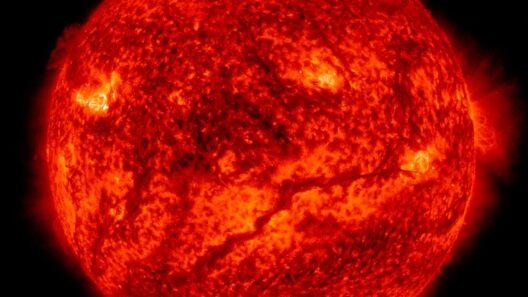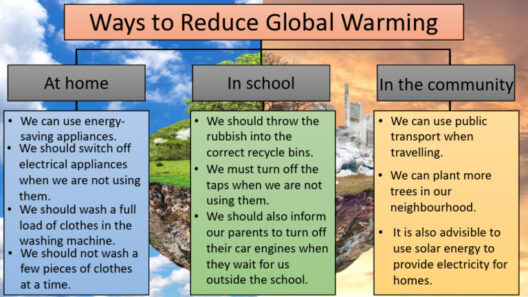El Niño, a recurring climatic phenomenon characterized by the warming of sea surface temperatures in the central and eastern Pacific Ocean, has garnered significant attention for its substantial influence on global weather patterns. This natural event not only affects localized climates but also offers a lens through which to examine broader climatic shifts, particularly those associated with global warming. The interplay between El Niño and climate change prompts a multifaceted discussion that warrants exploration.
To comprehend the implications of El Niño on global warming, it is essential to first elucidate what El Niño entails. Occurring every two to seven years, this phenomenon disrupts usual weather patterns, often leading to increased rainfall in the southern United States and drought conditions in Australia and Southeast Asia. The consequences of these disruptions can be dire, impacting agriculture, water supply, and even prompting economic downturns. Thus, the immediate effects of El Niño are palpable and often serve as a precursor to understanding how these cycles correlate with long-term climate trends.
The relationship between El Niño and global warming is intricate. Climate change, fundamentally driven by anthropogenic greenhouse gas emissions, is reshaping the planet’s climate systems. A warming planet intensifies the effects of El Niño, creating what can be described as a feedback loop. As global temperatures rise, the likelihood and intensity of El Niño events can increase. This exacerbation raises concerns about the feedback mechanisms in the climate system—does a warmer Earth mean stronger El Niño episodes, and if so, what implications does this have for long-term climate patterns?
Recent studies suggest that under future climate scenarios, particularly those projected by various climate models, the frequency and intensity of El Niño events may indeed increase. This expectation stems from enhanced ocean-atmosphere interactions linked to higher sea surface temperatures. As the ocean warms, the heat content available to fuel El Niño becomes more pronounced, potentially leading to extreme weather events and significant disruptions across different regions worldwide. The ramifications of this increased intensity can be catastrophic, raising global sea levels, altering precipitation patterns, and intensifying storm systems.
The implications of intensified El Niño events are particularly critical in the context of food security and freshwater availability. Agriculture is highly susceptible to climate variability, and El Niño’s influence can wreak havoc on crop production. For instance, in regions like the Horn of Africa, even short-term climatic disruptions can lead to widespread famine and economic distress. Furthermore, as rainfall patterns shift due to El Niño, water availability becomes increasingly erratic, complicating management for communities dependent on consistent water sources.
Another noteworthy aspect of the El Niño phenomenon is its impact on global ecosystems. Coral reefs, which are already under threat from ocean acidification, face additional stress during El Niño events due to increased water temperatures. These temperature spikes can lead to coral bleaching, a process that can decimate marine biodiversity and disrupt food chains. The resultant loss of biodiversity has profound implications not only for marine environments but also for the livelihoods of those who depend on these ecosystems for sustenance and economic stability.
As we investigate the interrelation between El Niño and global warming, it is crucial to consider the unpredictability of climate systems. Despite advanced climate models, predicting the precise impacts of El Niño in conjunction with climate change remains challenging. The erratic nature of these interactions can lead to unforeseen consequences. For instance, while a stronger El Niño may generate more rainfall in some regions, others may experience exacerbated drought conditions. This complexity necessitates a comprehensive understanding of regional climatic patterns and the socio-economic frameworks in place to address potential fallout.
Moreover, the perspectives surrounding El Niño and climate change are evolving. Discussions related to climate resilience and adaptation strategies have gained prominence as societies strive to address the immediate and long-term effects of climate variability. Communities are increasingly focusing on understanding their vulnerabilities and enhancing their adaptive capacities to mitigate the risks posed by intensified El Niño events. This proactive approach emphasizes the need for collaboration among governments, scientists, and local populations to devise effective strategies tailored to combat the range of climatic challenges.
Another dimension to this conversation involves technological advancements in climate forecasting and modeling. Enhanced predictive capabilities contribute to better preparedness for El Niño’s impacts. These systems allow for an informed understanding of how El Niño may interact with ongoing climate change, providing data that can help shape public policy and disaster preparedness initiatives. Education plays a vital role in this context, as disseminating knowledge about these phenomena fosters a culture of awareness and proactive engagement with climate-related issues.
As the world grapples with the realities of climate change, understanding the consequences of El Niño is integral to forging a resilient tomorrow. The juxtaposition of these two critical elements—El Niño and global warming—offers an opportunity to recalibrate our approach to environmental stewardship. By recognizing the profound impacts these phenomena have on weather patterns, ecosystems, and human livelihoods, societies can cultivate a sense of urgency and responsibility toward mitigating climate change and preparing for its inevitable consequences.
In summary, the intricate relationship between El Niño and global warming merits ongoing exploration and understanding. The phenomenon serves not only as an essential weather pattern but also as a crucial focal point for conversations surrounding climate change preparedness, resilience, and adaptation. Fostering a global dialogue on these issues is paramount to safeguarding the planet and ensuring a sustainable future for generations to come. With informed perspectives and collaborative efforts, humanity can rise to the challenges presented by climate change and work toward a more resilient and equitable world.








